SAPS Model and Digital Health: A Case Study of MPE Management
VerifiedAdded on 2023/06/23
|5
|1783
|411
Case Study
AI Summary
This case study examines the implementation of a specialized ambulatory pleural service (SAPS) model in Victoria, Australia, to enhance the management of malignant pleural effusion (MPE) through digital health technologies. Addressing the fragmented care models and limited access to expertise, the initiative utilizes telehealth, real-time remote pleural ultrasonography (teleultrasound), and symptom monitoring to provide specialist support in the community, reducing the need for hospitalization and invasive procedures. The study analyzes the perspectives of clinical, patient, psychological and technological aspects in designing the virtual care approaches and also addresses limitations such as technology dependence and the inability to conduct physical examinations. Employing the RE-AIM framework (Reach, Effectiveness, Adoption, Implementation, Maintenance), the case study assesses the program's impact and identifies areas for improvement, concluding that a virtual care model can significantly improve MPE management, patient outcomes, and access to specialist care.
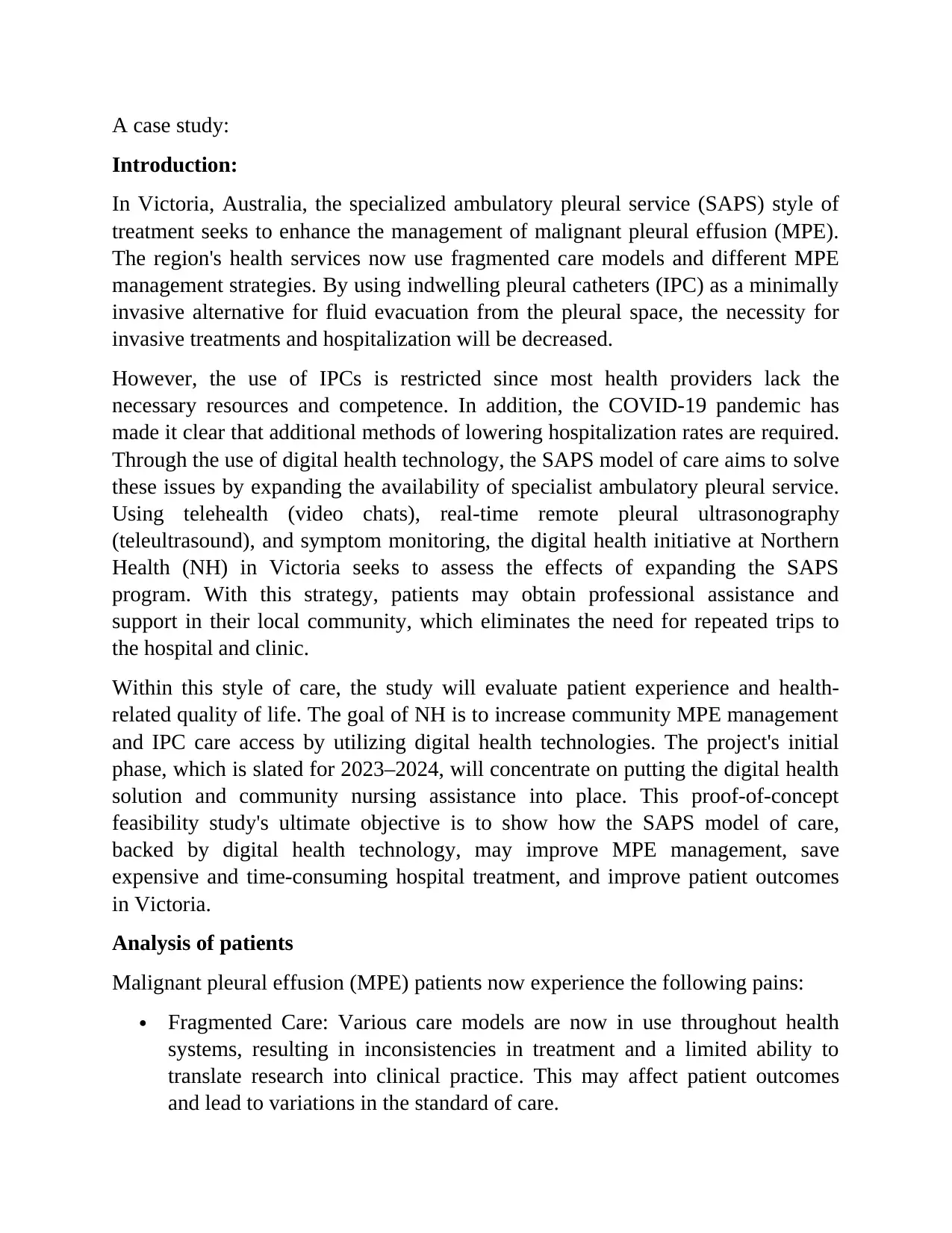
A case study:
Introduction:
In Victoria, Australia, the specialized ambulatory pleural service (SAPS) style of
treatment seeks to enhance the management of malignant pleural effusion (MPE).
The region's health services now use fragmented care models and different MPE
management strategies. By using indwelling pleural catheters (IPC) as a minimally
invasive alternative for fluid evacuation from the pleural space, the necessity for
invasive treatments and hospitalization will be decreased.
However, the use of IPCs is restricted since most health providers lack the
necessary resources and competence. In addition, the COVID-19 pandemic has
made it clear that additional methods of lowering hospitalization rates are required.
Through the use of digital health technology, the SAPS model of care aims to solve
these issues by expanding the availability of specialist ambulatory pleural service.
Using telehealth (video chats), real-time remote pleural ultrasonography
(teleultrasound), and symptom monitoring, the digital health initiative at Northern
Health (NH) in Victoria seeks to assess the effects of expanding the SAPS
program. With this strategy, patients may obtain professional assistance and
support in their local community, which eliminates the need for repeated trips to
the hospital and clinic.
Within this style of care, the study will evaluate patient experience and health-
related quality of life. The goal of NH is to increase community MPE management
and IPC care access by utilizing digital health technologies. The project's initial
phase, which is slated for 2023–2024, will concentrate on putting the digital health
solution and community nursing assistance into place. This proof-of-concept
feasibility study's ultimate objective is to show how the SAPS model of care,
backed by digital health technology, may improve MPE management, save
expensive and time-consuming hospital treatment, and improve patient outcomes
in Victoria.
Analysis of patients
Malignant pleural effusion (MPE) patients now experience the following pains:
Fragmented Care: Various care models are now in use throughout health
systems, resulting in inconsistencies in treatment and a limited ability to
translate research into clinical practice. This may affect patient outcomes
and lead to variations in the standard of care.
Introduction:
In Victoria, Australia, the specialized ambulatory pleural service (SAPS) style of
treatment seeks to enhance the management of malignant pleural effusion (MPE).
The region's health services now use fragmented care models and different MPE
management strategies. By using indwelling pleural catheters (IPC) as a minimally
invasive alternative for fluid evacuation from the pleural space, the necessity for
invasive treatments and hospitalization will be decreased.
However, the use of IPCs is restricted since most health providers lack the
necessary resources and competence. In addition, the COVID-19 pandemic has
made it clear that additional methods of lowering hospitalization rates are required.
Through the use of digital health technology, the SAPS model of care aims to solve
these issues by expanding the availability of specialist ambulatory pleural service.
Using telehealth (video chats), real-time remote pleural ultrasonography
(teleultrasound), and symptom monitoring, the digital health initiative at Northern
Health (NH) in Victoria seeks to assess the effects of expanding the SAPS
program. With this strategy, patients may obtain professional assistance and
support in their local community, which eliminates the need for repeated trips to
the hospital and clinic.
Within this style of care, the study will evaluate patient experience and health-
related quality of life. The goal of NH is to increase community MPE management
and IPC care access by utilizing digital health technologies. The project's initial
phase, which is slated for 2023–2024, will concentrate on putting the digital health
solution and community nursing assistance into place. This proof-of-concept
feasibility study's ultimate objective is to show how the SAPS model of care,
backed by digital health technology, may improve MPE management, save
expensive and time-consuming hospital treatment, and improve patient outcomes
in Victoria.
Analysis of patients
Malignant pleural effusion (MPE) patients now experience the following pains:
Fragmented Care: Various care models are now in use throughout health
systems, resulting in inconsistencies in treatment and a limited ability to
translate research into clinical practice. This may affect patient outcomes
and lead to variations in the standard of care.
Paraphrase This Document
Need a fresh take? Get an instant paraphrase of this document with our AI Paraphraser
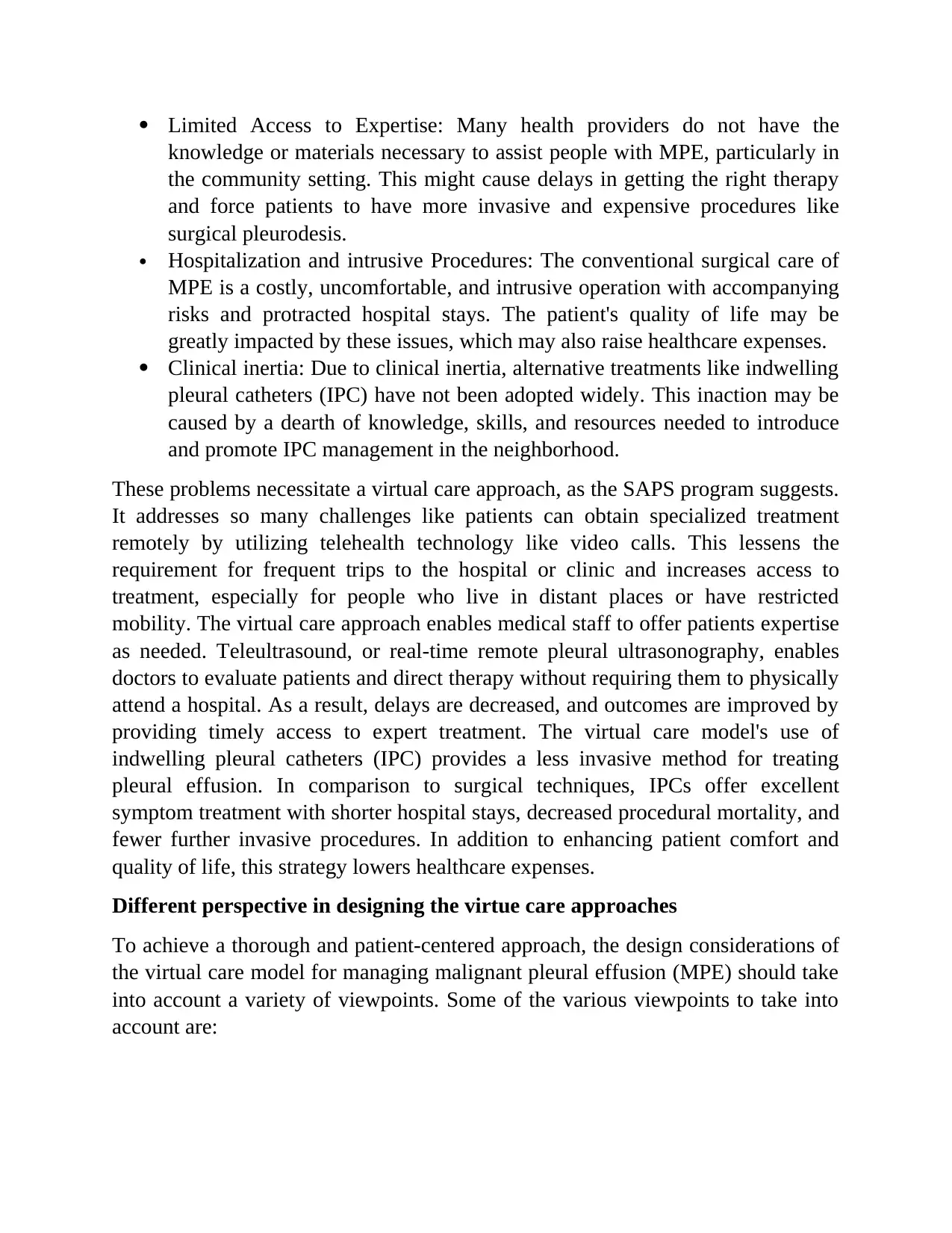
Limited Access to Expertise: Many health providers do not have the
knowledge or materials necessary to assist people with MPE, particularly in
the community setting. This might cause delays in getting the right therapy
and force patients to have more invasive and expensive procedures like
surgical pleurodesis.
Hospitalization and intrusive Procedures: The conventional surgical care of
MPE is a costly, uncomfortable, and intrusive operation with accompanying
risks and protracted hospital stays. The patient's quality of life may be
greatly impacted by these issues, which may also raise healthcare expenses.
Clinical inertia: Due to clinical inertia, alternative treatments like indwelling
pleural catheters (IPC) have not been adopted widely. This inaction may be
caused by a dearth of knowledge, skills, and resources needed to introduce
and promote IPC management in the neighborhood.
These problems necessitate a virtual care approach, as the SAPS program suggests.
It addresses so many challenges like patients can obtain specialized treatment
remotely by utilizing telehealth technology like video calls. This lessens the
requirement for frequent trips to the hospital or clinic and increases access to
treatment, especially for people who live in distant places or have restricted
mobility. The virtual care approach enables medical staff to offer patients expertise
as needed. Teleultrasound, or real-time remote pleural ultrasonography, enables
doctors to evaluate patients and direct therapy without requiring them to physically
attend a hospital. As a result, delays are decreased, and outcomes are improved by
providing timely access to expert treatment. The virtual care model's use of
indwelling pleural catheters (IPC) provides a less invasive method for treating
pleural effusion. In comparison to surgical techniques, IPCs offer excellent
symptom treatment with shorter hospital stays, decreased procedural mortality, and
fewer further invasive procedures. In addition to enhancing patient comfort and
quality of life, this strategy lowers healthcare expenses.
Different perspective in designing the virtue care approaches
To achieve a thorough and patient-centered approach, the design considerations of
the virtual care model for managing malignant pleural effusion (MPE) should take
into account a variety of viewpoints. Some of the various viewpoints to take into
account are:
knowledge or materials necessary to assist people with MPE, particularly in
the community setting. This might cause delays in getting the right therapy
and force patients to have more invasive and expensive procedures like
surgical pleurodesis.
Hospitalization and intrusive Procedures: The conventional surgical care of
MPE is a costly, uncomfortable, and intrusive operation with accompanying
risks and protracted hospital stays. The patient's quality of life may be
greatly impacted by these issues, which may also raise healthcare expenses.
Clinical inertia: Due to clinical inertia, alternative treatments like indwelling
pleural catheters (IPC) have not been adopted widely. This inaction may be
caused by a dearth of knowledge, skills, and resources needed to introduce
and promote IPC management in the neighborhood.
These problems necessitate a virtual care approach, as the SAPS program suggests.
It addresses so many challenges like patients can obtain specialized treatment
remotely by utilizing telehealth technology like video calls. This lessens the
requirement for frequent trips to the hospital or clinic and increases access to
treatment, especially for people who live in distant places or have restricted
mobility. The virtual care approach enables medical staff to offer patients expertise
as needed. Teleultrasound, or real-time remote pleural ultrasonography, enables
doctors to evaluate patients and direct therapy without requiring them to physically
attend a hospital. As a result, delays are decreased, and outcomes are improved by
providing timely access to expert treatment. The virtual care model's use of
indwelling pleural catheters (IPC) provides a less invasive method for treating
pleural effusion. In comparison to surgical techniques, IPCs offer excellent
symptom treatment with shorter hospital stays, decreased procedural mortality, and
fewer further invasive procedures. In addition to enhancing patient comfort and
quality of life, this strategy lowers healthcare expenses.
Different perspective in designing the virtue care approaches
To achieve a thorough and patient-centered approach, the design considerations of
the virtual care model for managing malignant pleural effusion (MPE) should take
into account a variety of viewpoints. Some of the various viewpoints to take into
account are:
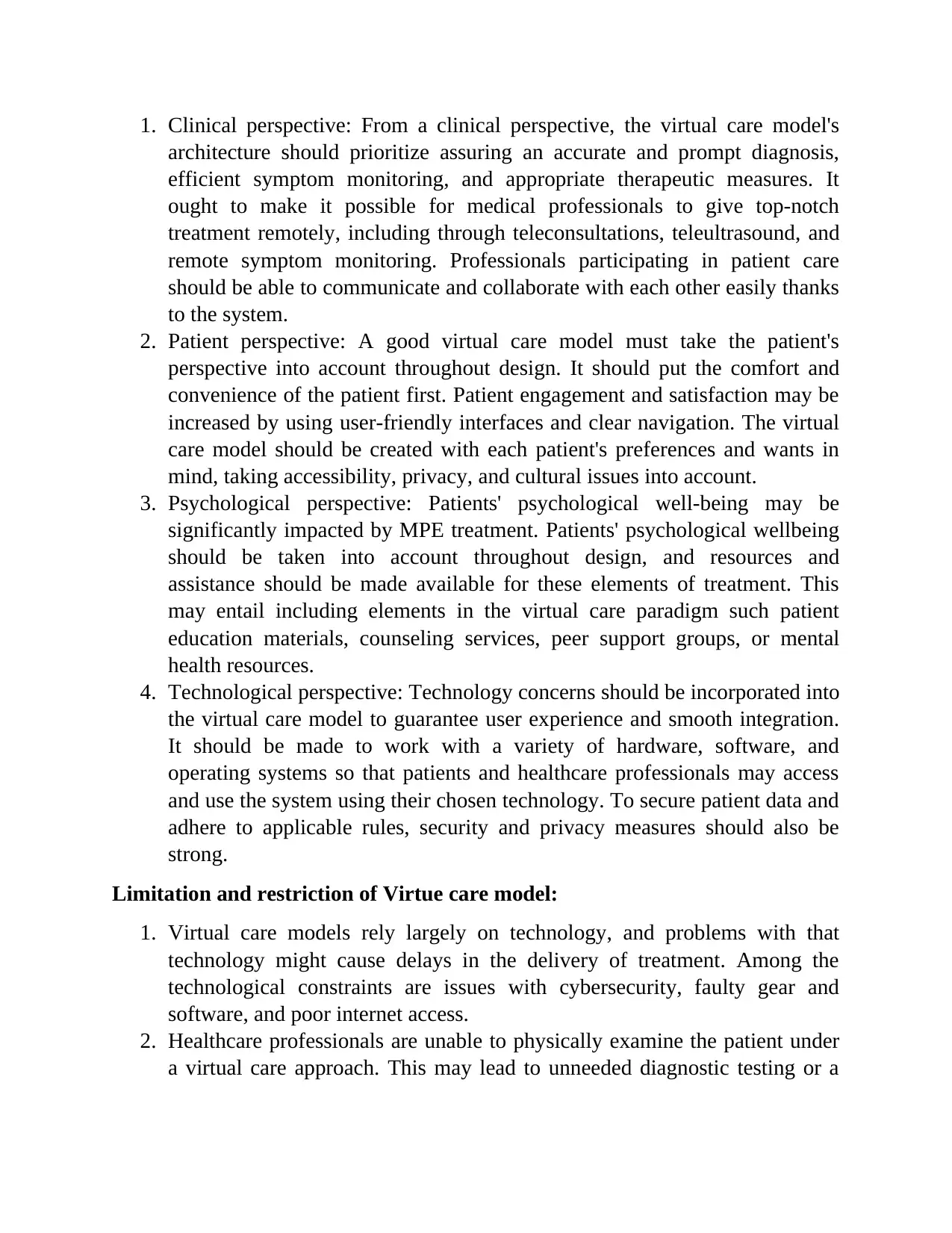
1. Clinical perspective: From a clinical perspective, the virtual care model's
architecture should prioritize assuring an accurate and prompt diagnosis,
efficient symptom monitoring, and appropriate therapeutic measures. It
ought to make it possible for medical professionals to give top-notch
treatment remotely, including through teleconsultations, teleultrasound, and
remote symptom monitoring. Professionals participating in patient care
should be able to communicate and collaborate with each other easily thanks
to the system.
2. Patient perspective: A good virtual care model must take the patient's
perspective into account throughout design. It should put the comfort and
convenience of the patient first. Patient engagement and satisfaction may be
increased by using user-friendly interfaces and clear navigation. The virtual
care model should be created with each patient's preferences and wants in
mind, taking accessibility, privacy, and cultural issues into account.
3. Psychological perspective: Patients' psychological well-being may be
significantly impacted by MPE treatment. Patients' psychological wellbeing
should be taken into account throughout design, and resources and
assistance should be made available for these elements of treatment. This
may entail including elements in the virtual care paradigm such patient
education materials, counseling services, peer support groups, or mental
health resources.
4. Technological perspective: Technology concerns should be incorporated into
the virtual care model to guarantee user experience and smooth integration.
It should be made to work with a variety of hardware, software, and
operating systems so that patients and healthcare professionals may access
and use the system using their chosen technology. To secure patient data and
adhere to applicable rules, security and privacy measures should also be
strong.
Limitation and restriction of Virtue care model:
1. Virtual care models rely largely on technology, and problems with that
technology might cause delays in the delivery of treatment. Among the
technological constraints are issues with cybersecurity, faulty gear and
software, and poor internet access.
2. Healthcare professionals are unable to physically examine the patient under
a virtual care approach. This may lead to unneeded diagnostic testing or a
architecture should prioritize assuring an accurate and prompt diagnosis,
efficient symptom monitoring, and appropriate therapeutic measures. It
ought to make it possible for medical professionals to give top-notch
treatment remotely, including through teleconsultations, teleultrasound, and
remote symptom monitoring. Professionals participating in patient care
should be able to communicate and collaborate with each other easily thanks
to the system.
2. Patient perspective: A good virtual care model must take the patient's
perspective into account throughout design. It should put the comfort and
convenience of the patient first. Patient engagement and satisfaction may be
increased by using user-friendly interfaces and clear navigation. The virtual
care model should be created with each patient's preferences and wants in
mind, taking accessibility, privacy, and cultural issues into account.
3. Psychological perspective: Patients' psychological well-being may be
significantly impacted by MPE treatment. Patients' psychological wellbeing
should be taken into account throughout design, and resources and
assistance should be made available for these elements of treatment. This
may entail including elements in the virtual care paradigm such patient
education materials, counseling services, peer support groups, or mental
health resources.
4. Technological perspective: Technology concerns should be incorporated into
the virtual care model to guarantee user experience and smooth integration.
It should be made to work with a variety of hardware, software, and
operating systems so that patients and healthcare professionals may access
and use the system using their chosen technology. To secure patient data and
adhere to applicable rules, security and privacy measures should also be
strong.
Limitation and restriction of Virtue care model:
1. Virtual care models rely largely on technology, and problems with that
technology might cause delays in the delivery of treatment. Among the
technological constraints are issues with cybersecurity, faulty gear and
software, and poor internet access.
2. Healthcare professionals are unable to physically examine the patient under
a virtual care approach. This may lead to unneeded diagnostic testing or a
⊘ This is a preview!⊘
Do you want full access?
Subscribe today to unlock all pages.

Trusted by 1+ million students worldwide
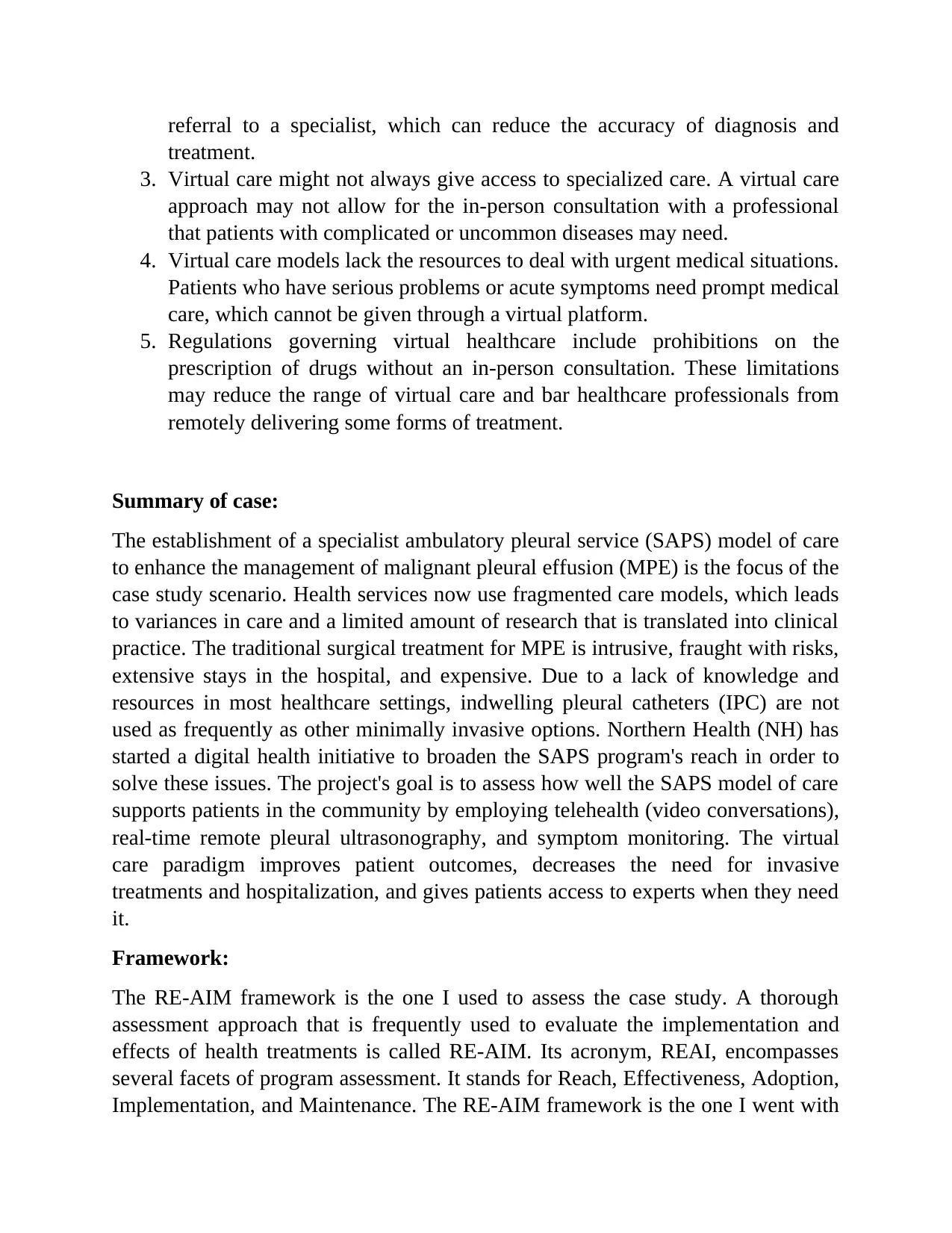
referral to a specialist, which can reduce the accuracy of diagnosis and
treatment.
3. Virtual care might not always give access to specialized care. A virtual care
approach may not allow for the in-person consultation with a professional
that patients with complicated or uncommon diseases may need.
4. Virtual care models lack the resources to deal with urgent medical situations.
Patients who have serious problems or acute symptoms need prompt medical
care, which cannot be given through a virtual platform.
5. Regulations governing virtual healthcare include prohibitions on the
prescription of drugs without an in-person consultation. These limitations
may reduce the range of virtual care and bar healthcare professionals from
remotely delivering some forms of treatment.
Summary of case:
The establishment of a specialist ambulatory pleural service (SAPS) model of care
to enhance the management of malignant pleural effusion (MPE) is the focus of the
case study scenario. Health services now use fragmented care models, which leads
to variances in care and a limited amount of research that is translated into clinical
practice. The traditional surgical treatment for MPE is intrusive, fraught with risks,
extensive stays in the hospital, and expensive. Due to a lack of knowledge and
resources in most healthcare settings, indwelling pleural catheters (IPC) are not
used as frequently as other minimally invasive options. Northern Health (NH) has
started a digital health initiative to broaden the SAPS program's reach in order to
solve these issues. The project's goal is to assess how well the SAPS model of care
supports patients in the community by employing telehealth (video conversations),
real-time remote pleural ultrasonography, and symptom monitoring. The virtual
care paradigm improves patient outcomes, decreases the need for invasive
treatments and hospitalization, and gives patients access to experts when they need
it.
Framework:
The RE-AIM framework is the one I used to assess the case study. A thorough
assessment approach that is frequently used to evaluate the implementation and
effects of health treatments is called RE-AIM. Its acronym, REAI, encompasses
several facets of program assessment. It stands for Reach, Effectiveness, Adoption,
Implementation, and Maintenance. The RE-AIM framework is the one I went with
treatment.
3. Virtual care might not always give access to specialized care. A virtual care
approach may not allow for the in-person consultation with a professional
that patients with complicated or uncommon diseases may need.
4. Virtual care models lack the resources to deal with urgent medical situations.
Patients who have serious problems or acute symptoms need prompt medical
care, which cannot be given through a virtual platform.
5. Regulations governing virtual healthcare include prohibitions on the
prescription of drugs without an in-person consultation. These limitations
may reduce the range of virtual care and bar healthcare professionals from
remotely delivering some forms of treatment.
Summary of case:
The establishment of a specialist ambulatory pleural service (SAPS) model of care
to enhance the management of malignant pleural effusion (MPE) is the focus of the
case study scenario. Health services now use fragmented care models, which leads
to variances in care and a limited amount of research that is translated into clinical
practice. The traditional surgical treatment for MPE is intrusive, fraught with risks,
extensive stays in the hospital, and expensive. Due to a lack of knowledge and
resources in most healthcare settings, indwelling pleural catheters (IPC) are not
used as frequently as other minimally invasive options. Northern Health (NH) has
started a digital health initiative to broaden the SAPS program's reach in order to
solve these issues. The project's goal is to assess how well the SAPS model of care
supports patients in the community by employing telehealth (video conversations),
real-time remote pleural ultrasonography, and symptom monitoring. The virtual
care paradigm improves patient outcomes, decreases the need for invasive
treatments and hospitalization, and gives patients access to experts when they need
it.
Framework:
The RE-AIM framework is the one I used to assess the case study. A thorough
assessment approach that is frequently used to evaluate the implementation and
effects of health treatments is called RE-AIM. Its acronym, REAI, encompasses
several facets of program assessment. It stands for Reach, Effectiveness, Adoption,
Implementation, and Maintenance. The RE-AIM framework is the one I went with
Paraphrase This Document
Need a fresh take? Get an instant paraphrase of this document with our AI Paraphraser
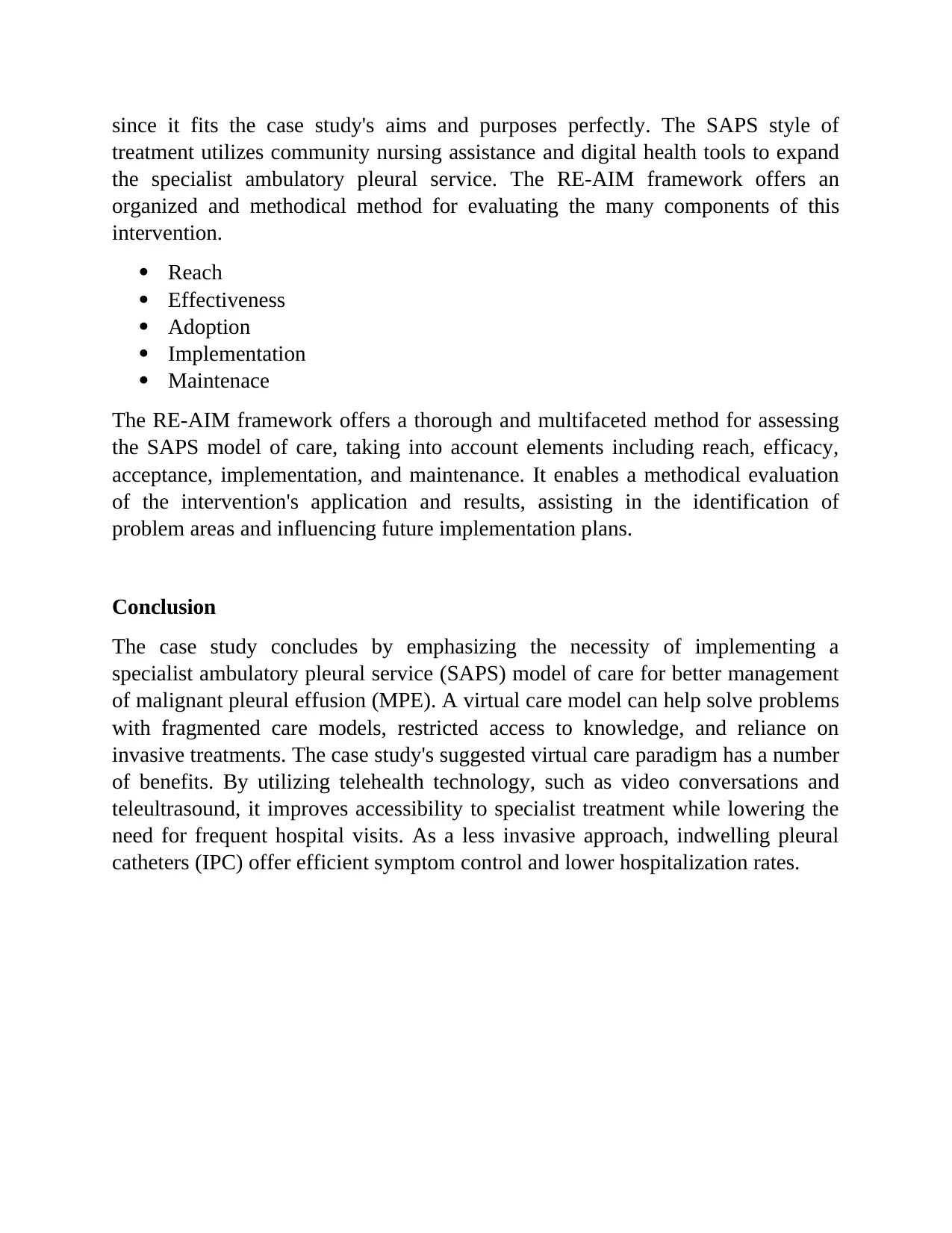
since it fits the case study's aims and purposes perfectly. The SAPS style of
treatment utilizes community nursing assistance and digital health tools to expand
the specialist ambulatory pleural service. The RE-AIM framework offers an
organized and methodical method for evaluating the many components of this
intervention.
Reach
Effectiveness
Adoption
Implementation
Maintenace
The RE-AIM framework offers a thorough and multifaceted method for assessing
the SAPS model of care, taking into account elements including reach, efficacy,
acceptance, implementation, and maintenance. It enables a methodical evaluation
of the intervention's application and results, assisting in the identification of
problem areas and influencing future implementation plans.
Conclusion
The case study concludes by emphasizing the necessity of implementing a
specialist ambulatory pleural service (SAPS) model of care for better management
of malignant pleural effusion (MPE). A virtual care model can help solve problems
with fragmented care models, restricted access to knowledge, and reliance on
invasive treatments. The case study's suggested virtual care paradigm has a number
of benefits. By utilizing telehealth technology, such as video conversations and
teleultrasound, it improves accessibility to specialist treatment while lowering the
need for frequent hospital visits. As a less invasive approach, indwelling pleural
catheters (IPC) offer efficient symptom control and lower hospitalization rates.
treatment utilizes community nursing assistance and digital health tools to expand
the specialist ambulatory pleural service. The RE-AIM framework offers an
organized and methodical method for evaluating the many components of this
intervention.
Reach
Effectiveness
Adoption
Implementation
Maintenace
The RE-AIM framework offers a thorough and multifaceted method for assessing
the SAPS model of care, taking into account elements including reach, efficacy,
acceptance, implementation, and maintenance. It enables a methodical evaluation
of the intervention's application and results, assisting in the identification of
problem areas and influencing future implementation plans.
Conclusion
The case study concludes by emphasizing the necessity of implementing a
specialist ambulatory pleural service (SAPS) model of care for better management
of malignant pleural effusion (MPE). A virtual care model can help solve problems
with fragmented care models, restricted access to knowledge, and reliance on
invasive treatments. The case study's suggested virtual care paradigm has a number
of benefits. By utilizing telehealth technology, such as video conversations and
teleultrasound, it improves accessibility to specialist treatment while lowering the
need for frequent hospital visits. As a less invasive approach, indwelling pleural
catheters (IPC) offer efficient symptom control and lower hospitalization rates.
1 out of 5
Your All-in-One AI-Powered Toolkit for Academic Success.
+13062052269
info@desklib.com
Available 24*7 on WhatsApp / Email
![[object Object]](/_next/static/media/star-bottom.7253800d.svg)
Unlock your academic potential
Copyright © 2020–2025 A2Z Services. All Rights Reserved. Developed and managed by ZUCOL.
